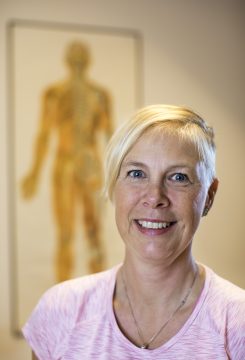
DOCTORAL THESIS. In patients with heart failure and/or atrial fibrillation, physical fitness improves if individualised physiotherapist-led exercise-based cardiac rehabilitation is provided. This method yields better results than physical activity on prescription for these patients, a thesis shows.
Patients with chronic heart failure often experience symptoms such as low exercise capacity, breathlessness and a short walking distance. Living with atrial fibrillation, also results in impaired physical fitness, and often anxiety about overloading the heart. It is mainly older people who are affected by these diseases.
“Many patients avoid physical activity and exercise because of fear of overstraining the heart. I believe they get vital social support from being able to exercise with others in the exercise-based cardiac rehabilitation. There, they dare exert themselves more, since it’s individualised and supervised by a physiotherapist.”

The speaker is Maria Borland, who has a PhD from Sahlgrenska Academy, University of Gothenburg, and is a physiotherapist specialised in Cardiology, in primary care in Västra Götaland, southwest Sweden. One paper forming part of her thesis relates to 42 elderly patients with heart failure who also had other diseases, including diabetes and high blood pressure. Under a physiotherapist’s supervision, these patients underwent exercise that comprised both cycling and strength training in individual prescribed exercise.
“Exercising one muscle at a time doesn’t strain the cardiorespiratory system; however, the patient can still work with a relative high load and strengthen the muscles. I could see that the patients were able to exercise more vigorously, with a better exercise capacity and greater muscular stamina. Their own perception was also that the exercise made them more physically active,” Borland says.
Exercise-based cardiac rehabilitation is beneficial for patients with atrial fibrillation too
Previous research has shown that improved aerobic fitness and muscle strength in older people with heart failure give them a better prognosis and results in fewer hospital admissions. Where atrial fibrillation is concerned, the scientific basis is weaker; but current research shows that, if the right requirements are met, aerobic fitness and muscular strength training helps this group as well.
Another paper included in Borland’s thesis describes how 96 patients with permanent atrial fibrillation were divided into two groups. One group underwent physiotherapy led group-based exercise in a cardiac rehabilitation center. The other received physical activity on prescription, in these cases in the form of getting active walks prescribed.
“Those who exercised with a physiotherapist in the cardiac rehabilitation center achieved a clear improvement in physical fitness, but there was no effect at all for those who went for active walks on their own. Walking simply didn’t involve sufficient intensity to give results,” Borland says.

Large group in need of help
Although there is no central recommendation from the Swedish National Board of Health and Welfare on exercise in cardiac rehabilitation for atrial fibrillation, this is offered at the hospital in Alingsås where Maria Borland works. There, the patients get individualised prescribed exercise by a physiotherapist.
“Patients with atrial fibrillation are a large group that we could really help. But at many other places today they don’t have the option of taking part in cardiac rehabilitation at all,” Maria Borland says.
Some 200,000 people in Sweden are estimated to have heart failure, and roughly, 300,000 have atrial fibrillation.
Titel: Exercise-based cardiac rehabilitation, physical fitness, and physical activity in cardiac disease; http://hdl.handle.net/2077/56882
TEXT: ELIN LINDSTRÖM CLAESSEN











